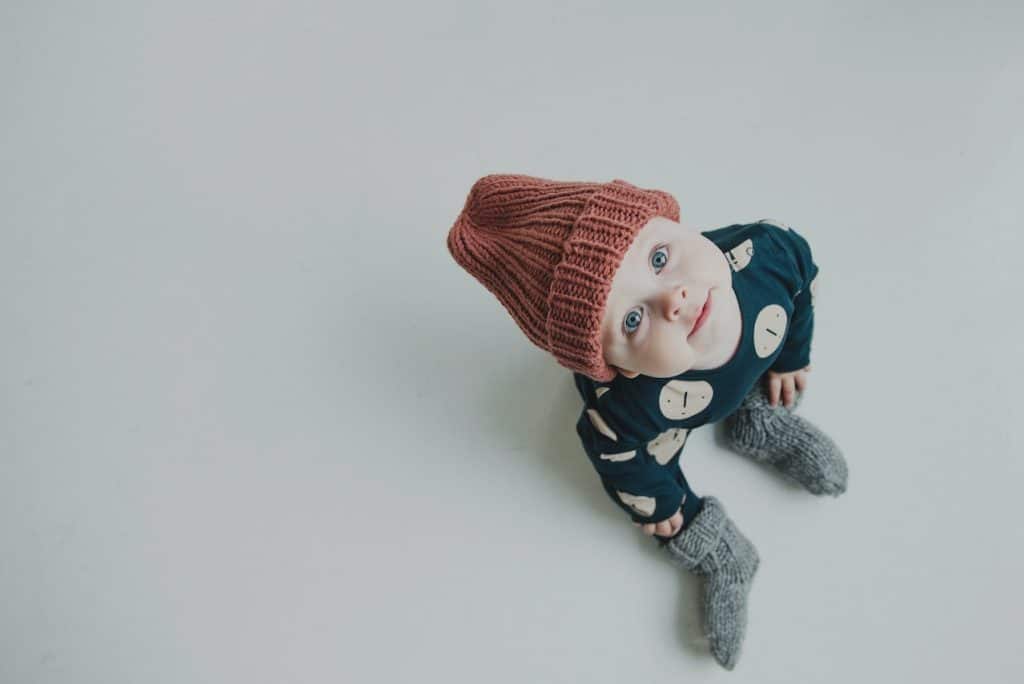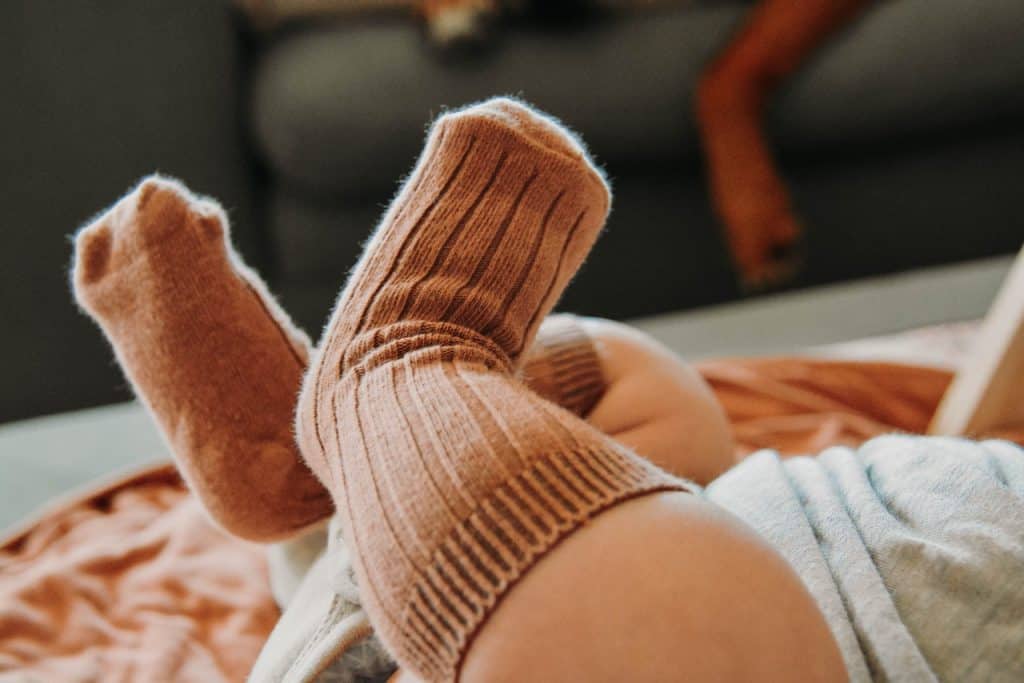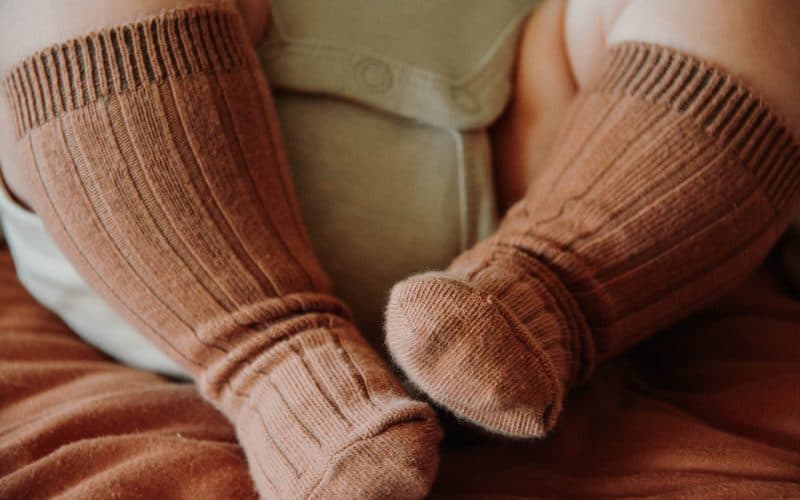It is the time of year when family and friends gather indoors to celebrate the season and keep warm. However, with festive gatherings also comes the potential for illness.
Being a parent to little ones can be worrisome with the cold and flu season underway. Many of the symptoms can be unpleasant and scary, especially fevers when newborns or babies are concerned.
When a fever presents itself, your primary goal is to monitor it and try to keep it down.
Since children may experience sweating and chills during a fever, it is difficult to figure out what you should do. You may wonder how to dress your child and whether you should put socks on your baby with a fever.
That depends on your child’s temperature and whether they’re shivering or sweating. The goal, however, is to dress your child lightly and not allow them to overheat since overdressing your child may trap body heat and lead to higher temperatures.
Things to Know About Babies and Fevers

1. Monitor Your Child’s Temperature
Oftentimes your child may feel uncomfortable or hotter than their temperature is. When this happens, it is important to determine their true temperature so you can take the best course of action.
According to the Mayo Clinic, rectal (via rectum) and temporal artery readings are the most accurate, especially for children under 3 months of age, with armpit readings being the least accurate.
A normal temperature range is between 97.6 and 100.3⁰F (36.5-37.9⁰C). A temperature on or above 100.4⁰F (38⁰C) is considered a fever.
A temperature above 104⁰F (40⁰C) may require immediate attention.
2. How to Dress Baby with a Fever
Dress your baby in light, breathable clothing, such as cotton or linen when they’re experiencing a fever. Select comfortable pajamas or a soft sleep sack, and thin socks for bedtime.
But don’t underdress your child either. If they get too cold or shiver too much it may cause their temperature to climb as well.
Physicians at the Children’s Hospital of Philadelphia emphasize that when “babies are cold-stressed, they use energy and oxygen to generate warmth,” which may lead to higher fevers and cause undue stress on their bodies.
In contrast, bundling up your baby with blankets, extra clothes, or thick socks when they have a fever may prevent their temperature from coming down and it may even get higher due to overheating.
3. Should I Put Socks on Baby with a Fever?

While a fever is the body’s natural immune response to an infection, it is still concerning when your baby feels unwell.
During a fever, you’ll want to keep your baby as comfortable as possible, and you may consider putting socks on them.
Monitor your baby’s temperature and dress them accordingly. In general, if your child is cold or shivering, you should put socks on them to help them regulate their temperature.
Helping your baby maintain an optimal temperature will aid them in conserving energy and building up their reserves, most likely lost during their fever.
4. When to Put Socks on Baby with a Fever
Monitor your baby’s temperature regularly while they’re feverish; every 15 to 30 minutes.
If your baby has a fever, you may opt out of putting socks on them since the extra clothing may trap body heat and cause their temperature to rise. Thin socks and clothing are the best options during a fever.
If, however, your child experiences chills or seems cold, you may put socks on them to prevent their temperature from rising. This typically happens when your child’s fever breaks.
When putting your baby to bed with a high temperature, skip the socks if they are sleeping with a footed onesie or a sleep sack. If, however, they are sleeping with pants, footless pajamas, or in their diapers, socks may be a good option.
5. Types of Socks to Put on Baby with a Fever
The type of socks you choose for your baby while they’re sick will depend on their state.
While your baby is experiencing a high temperature, you’ll want to put thin, soft, breathable socks on them, such as cotton so that heat isn’t trapped in their body and can escape.
As their fever breaks, they’ll sweat and will need to cool down. Thin, breathable socks will continue to help keep their feet dry and release heat.
However, if your child starts to shiver and their feet are cold to the touch, thicker socks might be necessary. In some places where there may be extreme cold, wool socks will do the job.
6. Try the Wet Sock Treatment
Although there is no scientific evidence to support the wet sock treatment, there are many anecdotes of it helping children with congestion and illness.
The naturopathic treatment entails warming up your baby’s feet with warm water, soaking thin, cotton socks in ice-cold water, ringing the excess water off, placing them on your child’s feet, and immediately covering them with thick socks, such as wool.
Put your baby to bed, and you should see them breathe easier while their blood circulation increases, giving their immune system a boost.
Final Thoughts
Watching your child endure an infection or an illness may prove difficult as a parent, especially when fevers are involved.
Bringing their temperature down and making them comfortable will be your main priority. You may have many questions on how to help your child, such as if you should put socks on your baby with a fever.
Monitoring your child’s temperature and knowing more about whether you should put socks on your baby, when, and what type will help them through the cold and flu festive season.
